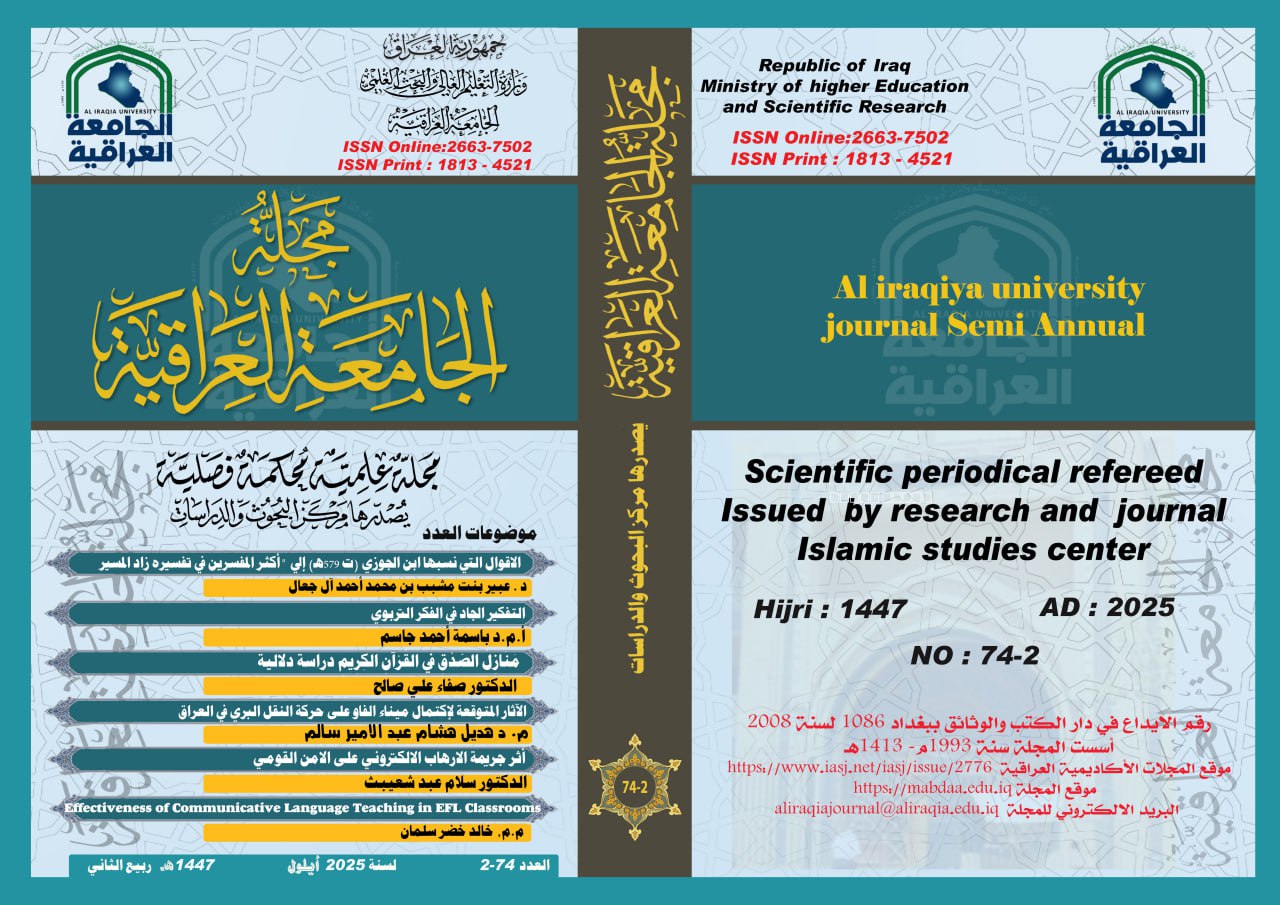Abstract
Research Summary
This research deals with the phrase "most of the commentators" as it appears in the Tafsir Zad al-Masir by Ibn al-Jawzi (d. 579 AH), and aims to reveal the significance of this formula and its weighted contexts, by extrapolating all the places where Ibn al-Jawzi used this expression, and analyzing them in the light of the statements of the advanced commentators, to determine the extent to which this ratio corresponds to what the majority of commentators believe.In studying these issues, I have relied on an inductive method to limit the positions of the phrase, an analysis to understand its contexts and its interpretive function, and a comparison to balance what Ibn al-Jawzi mentioned with what has been proven in the books of commentators, such as Ibn Jarir al-Tabari, al-Baghawi, al-Tha'labi, al-Mawardi, and others.The results of the study showed that Ibn al-Jawzi used the phrase "the most interpreter" in sixteen places, of which it was found after tracking and analysis that fifteen of them agreed with what the audience agreed with in the sentence, while one place was mentioned that is not correct to be described as the statement of the most, which reveals the accuracy of his use of this phrase in the sentence, and highlights the importance of reviewing such phrases with scientific accuracy, as they are effective interpretive tools in the process of weighting and determining the meaning
This research deals with the phrase "most of the commentators" as it appears in the Tafsir Zad al-Masir by Ibn al-Jawzi (d. 579 AH), and aims to reveal the significance of this formula and its weighted contexts, by extrapolating all the places where Ibn al-Jawzi used this expression, and analyzing them in the light of the statements of the advanced commentators, to determine the extent to which this ratio corresponds to what the majority of commentators believe.In studying these issues, I have relied on an inductive method to limit the positions of the phrase, an analysis to understand its contexts and its interpretive function, and a comparison to balance what Ibn al-Jawzi mentioned with what has been proven in the books of commentators, such as Ibn Jarir al-Tabari, al-Baghawi, al-Tha'labi, al-Mawardi, and others.The results of the study showed that Ibn al-Jawzi used the phrase "the most interpreter" in sixteen places, of which it was found after tracking and analysis that fifteen of them agreed with what the audience agreed with in the sentence, while one place was mentioned that is not correct to be described as the statement of the most, which reveals the accuracy of his use of this phrase in the sentence, and highlights the importance of reviewing such phrases with scientific accuracy, as they are effective interpretive tools in the process of weighting and determining the meaning
Keywords
Keywords: Ibn Al-Jawzi – Zad Al-Masir – Most of the Commentators – Terms of Interpretation – Weighting of Sayings – Formulas.
Abstract
ملخص البحث
يتناول هذا البحث عبارة "أكثر المفسرين" كما وردت في تفسير زاد المسير لابن الجوزي (ت 579هـ)، ويهدف إلى الكشف عن دلالات هذه الصيغة وسياقاتها الترجيحية، من خلال استقراء جميع المواضع التي استخدم فيها ابن الجوزي هذا التعبير، وتحليلها في ضوء أقوال المفسرين المتقدّمين، للوقوف على مدى مطابقة هذه النسبة لما عليه جمهور المفسرين.وقد اعتمدت في دراسة هذه المسائل على منهج استقرائيّ لحصر مواضع العبارة، وتحليليّ لفهم سياقاتها ووظيفتها التفسيرية، ومقارنٍ لموازنة ما أورده ابن الجوزي مع ما ثبت في كتب المفسرين، كابن جرير الطبري، والبغوي، والثعلبي، والماوردي، وغيرهم.وقد أظهرت نتائج الدراسة أن ابن الجوزي استعمل عبارة "أكثر المفسرين" في ستة عشر موضعًا، تبيَّن بعد التتبع والتحليل أن خمسة عشر منها تُوافق ما عليه الجمهور في الجملة، في حين ورد موضع واحد لا يصحُّ وصفه بأنه قول الأكثر، مما يكشف عن دقة استعماله لهذه العبارة في الجملة، ويبرز أهمية مراجعة مثل هذه العبارات بدقة علمية، بوصفها أدوات تفسيرية مؤثرة في مسار الترجيح وتقرير المعنى
يتناول هذا البحث عبارة "أكثر المفسرين" كما وردت في تفسير زاد المسير لابن الجوزي (ت 579هـ)، ويهدف إلى الكشف عن دلالات هذه الصيغة وسياقاتها الترجيحية، من خلال استقراء جميع المواضع التي استخدم فيها ابن الجوزي هذا التعبير، وتحليلها في ضوء أقوال المفسرين المتقدّمين، للوقوف على مدى مطابقة هذه النسبة لما عليه جمهور المفسرين.وقد اعتمدت في دراسة هذه المسائل على منهج استقرائيّ لحصر مواضع العبارة، وتحليليّ لفهم سياقاتها ووظيفتها التفسيرية، ومقارنٍ لموازنة ما أورده ابن الجوزي مع ما ثبت في كتب المفسرين، كابن جرير الطبري، والبغوي، والثعلبي، والماوردي، وغيرهم.وقد أظهرت نتائج الدراسة أن ابن الجوزي استعمل عبارة "أكثر المفسرين" في ستة عشر موضعًا، تبيَّن بعد التتبع والتحليل أن خمسة عشر منها تُوافق ما عليه الجمهور في الجملة، في حين ورد موضع واحد لا يصحُّ وصفه بأنه قول الأكثر، مما يكشف عن دقة استعماله لهذه العبارة في الجملة، ويبرز أهمية مراجعة مثل هذه العبارات بدقة علمية، بوصفها أدوات تفسيرية مؤثرة في مسار الترجيح وتقرير المعنى
Keywords
الكلمات المفتاحية: ابن الجوزي – زاد المسير – أكثر المفسرين – مصطلحات التفسير – ترجيح الأقوال – الصيغ المرادفة.
